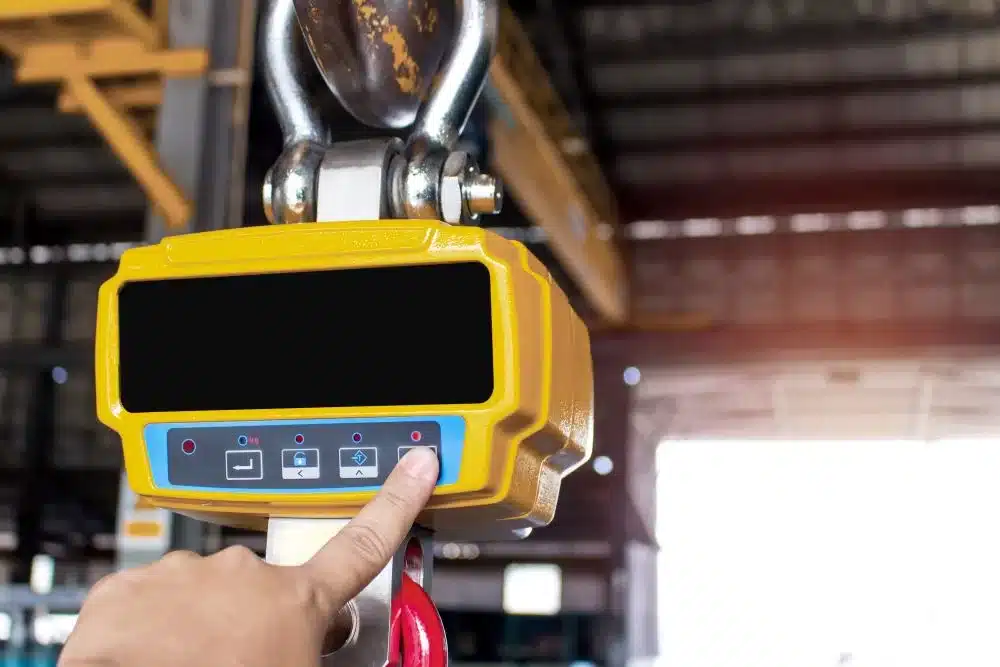
In industrial environments where heavy loads must be weighed safely and accurately, crane weight scales play a vital role. These powerful devices are essential in sectors such as construction, shipping, steel manufacturing, aerospace, and logistics. But have you ever wondered how these compact instruments can weigh massive suspended loads with precision? In this blog, we will break down the working principle of crane weight scales, explore their components, and explain why they are a critical investment for modern businesses.
What Is a Crane Weight Scale?
A crane weight scale is a type of load cell-based weighing system designed to measure the weight of heavy objects suspended from a crane or hoist. These scales are typically used in overhead crane systems and are built to withstand extreme conditions, including high tension, temperature fluctuations, and dynamic loads.
They help improve safety, reduce material handling time, and provide accurate weight readings for inventory and quality control purposes.
Key Components of a Crane Weight Scale
Understanding how crane weight scales work starts with knowing their basic components:
1. Load Cell
The heart of any crane scale is the load cell, which converts mechanical force (weight) into an electrical signal. When a load is suspended from the hook of the crane scale, the load cell deforms slightly. This deformation is translated into a voltage signal, which corresponds to the amount of weight applied.
2. Hook and Shackle
The hook is used to attach the load to the scale, while the shackle connects the scale to the crane. These parts must be made of high-strength alloy steel to support large weights safely.
3. Digital Display Unit
The display unit shows the real-time weight of the suspended object. In modern systems, this is often a wireless remote or handheld terminal that allows the operator to view the weight from a safe distance.
4. Microcontroller and Battery
The microcontroller processes the signals received from the load cell and calculates the accurate weight. It is powered by a long-lasting rechargeable battery, which enables the crane weight scale to function in remote or outdoor environments.
5. Housing and Enclosure
The entire mechanism is enclosed in a rugged housing, often made from stainless steel or aluminum, providing protection against dust, water, and mechanical damage.
Working Principle of a Crane Weight Scale
The functioning of a crane weight scale is based on the principle of strain gauge technology and electromechanical conversion. Here’s how it works:
- Load Suspension: The object to be weighed is hooked or slung beneath the crane, connected to the crane weight scale.
- Strain on Load Cell: As the object is lifted, its weight causes a force to act on the internal load cell.
- Deformation and Signal Generation: The strain gauge in the load cell deforms slightly due to this force. This deformation changes the electrical resistance within the gauge.
- Signal Conversion: The change in resistance is converted into an analog electrical signal.
- Signal Processing: The analog signal is processed by the microcontroller and converted into a digital reading.
- Weight Display: The digital reading is shown on the display unit in the desired unit (kg, lb, etc.), providing an accurate measurement of the suspended load.
Applications of Crane Weight Scales
Crane weight scales are used in a wide range of industries due to their portability and accuracy:
1. Construction and Steel Yards
Used to weigh steel girders, rebar bundles, and structural components before transport or installation.
2. Logistics and Shipping
Ideal for weighing cargo containers and palletized goods directly during the lifting process—saving time and labor.
3. Aerospace and Manufacturing
Helps monitor and verify the weight of aircraft components and precision-machined parts.
4. Foundries and Heavy Engineering
Used to weigh molten metal ladles, large castings, and industrial equipment before dispatch.
Benefits of Using a Crane Weight Scale
Safety
One of the top advantages is the ability to weigh loads while suspended, eliminating the need for transferring heavy materials to a traditional floor scale—thus reducing the risk of injury and accidents.
Real-Time Data
Modern crane scales can transmit data wirelessly to control rooms or mobile devices, allowing for real-time monitoring and tracking.
Time Efficiency
Operators can weigh goods during the lifting or transfer process, significantly improving productivity and workflow efficiency.
Accuracy
Advanced models offer precision within ±0.1% of the applied load, making them suitable even for high-stakes applications such as aerospace and pharmaceutical manufacturing.
Durability
Designed for rugged use, these scales are built with industrial-grade materials and can withstand rough handling, temperature extremes, and mechanical stress.
Key Factors to Consider When Choosing a Crane Weight Scale
If you’re looking to invest in a crane weight scale, here are a few factors to consider:
- Maximum Capacity: Ensure the scale supports your heaviest loads.
- Accuracy Requirements: Choose a model with the accuracy suited for your application.
- Display Options: Consider wireless or remote displays for added safety and convenience.
- Battery Life: Look for long-lasting batteries, especially if the scale will be used in remote areas.
- Durability and IP Rating: If working in harsh environments, choose a scale with high ingress protection (IP) rating.
- Certifications: For legal or high-precision use, ensure your scale meets industry standards (e.g., ISO, OIML).
Common Variants of Crane Weight Scales
1. Digital Crane Scale
Most commonly used; offers wireless display, rechargeable battery, and user-friendly interfaces.
2. Heavy-Duty Crane Scale
Designed for extremely large weights, often used in steel mills and shipyards.
3. Mini Crane Scale
Used for lighter loads or compact spaces; suitable for labs or small fabrication shops.
Maintenance and Safety Tips
To ensure long service life and optimal performance:
- Regularly inspect hooks, shackles, and the load cell.
- Calibrate the scale periodically to maintain accuracy.
- Keep the scale clean and dry to avoid corrosion and sensor failure.
- Avoid overloading, which can damage internal components.
- Train operators to use the device properly and interpret readings correctly.
Conclusion
Crane weight scales have revolutionized the way industries weigh large and heavy materials. By integrating strain gauge technology with rugged design, these scales offer unmatched convenience, safety, and accuracy. Whether in shipping yards, construction sites, or manufacturing plants, a crane weight scale ensures that weighing operations are faster, safer, and more efficient. If your business involves lifting and moving heavy loads, investing in a reliable crane scale can provide a solid return in both productivity and safety.



